牛津译林版(2019) 必修 第三册 Unit 1 Nature in the balance Reading课件(37张PPT)
文档属性
| 名称 | 牛津译林版(2019) 必修 第三册 Unit 1 Nature in the balance Reading课件(37张PPT) | 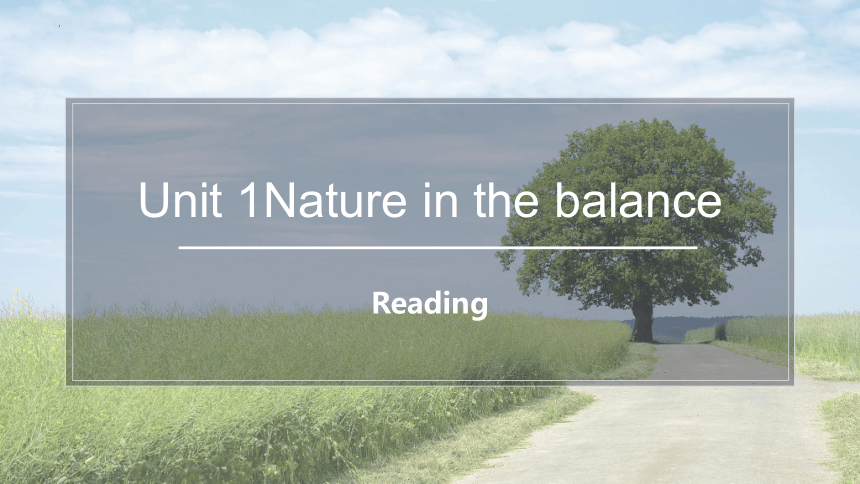 | |
| 格式 | pptx | ||
| 文件大小 | 101.5MB | ||
| 资源类型 | 教案 | ||
| 版本资源 | 牛津译林版(2019) | ||
| 科目 | 英语 | ||
| 更新时间 | 2023-03-09 12:56:59 | ||
图片预览


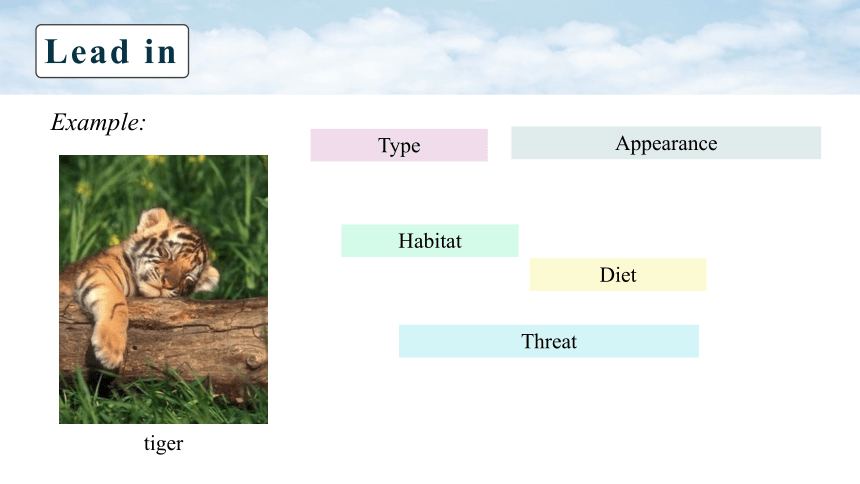
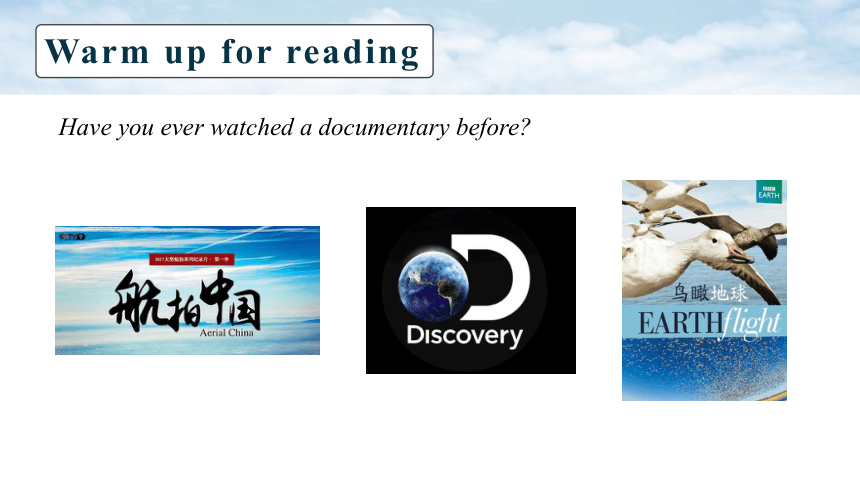
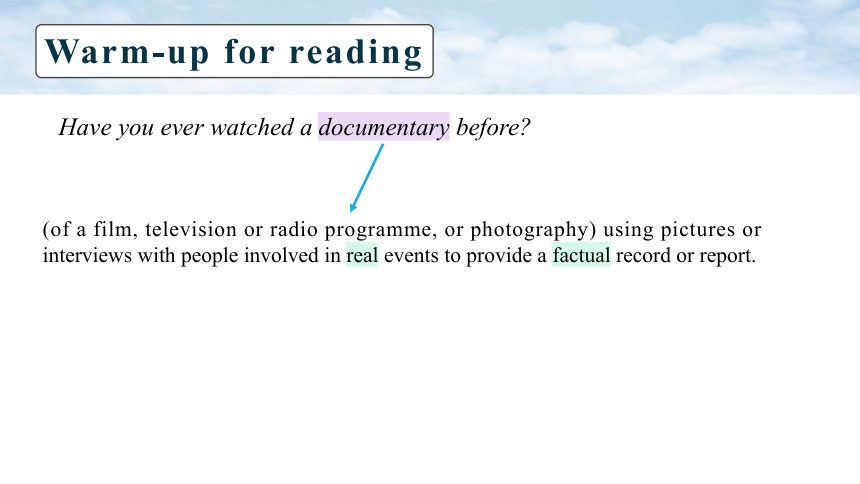
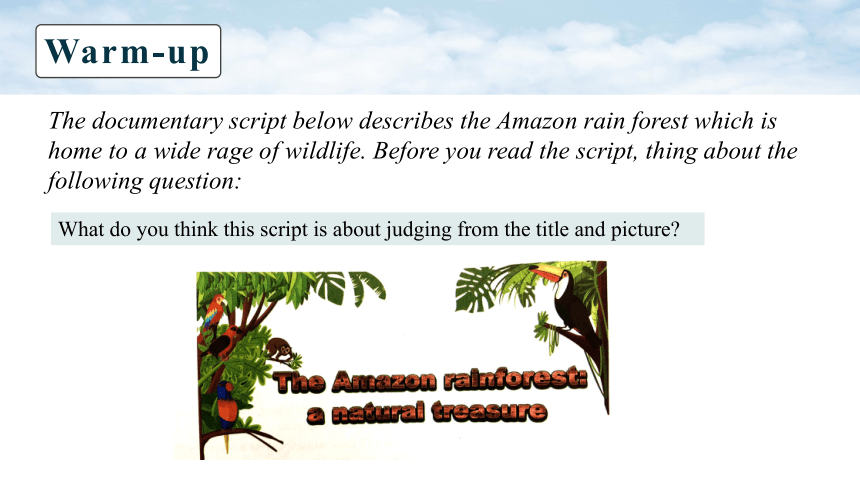
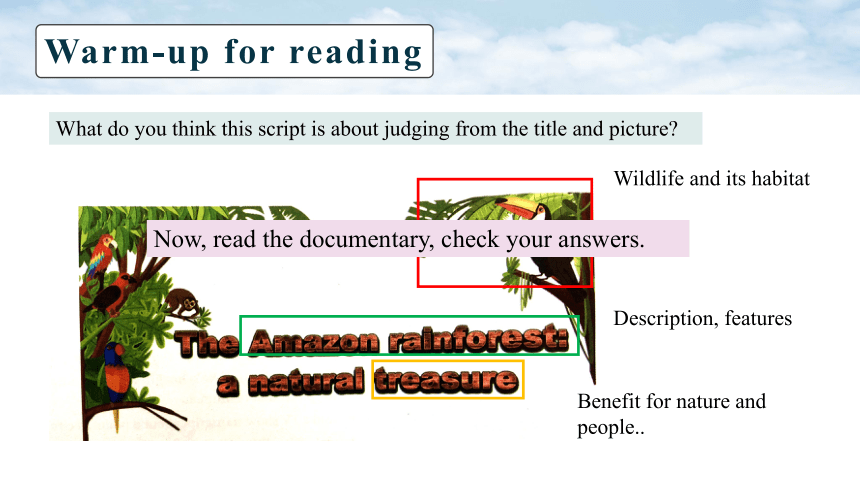
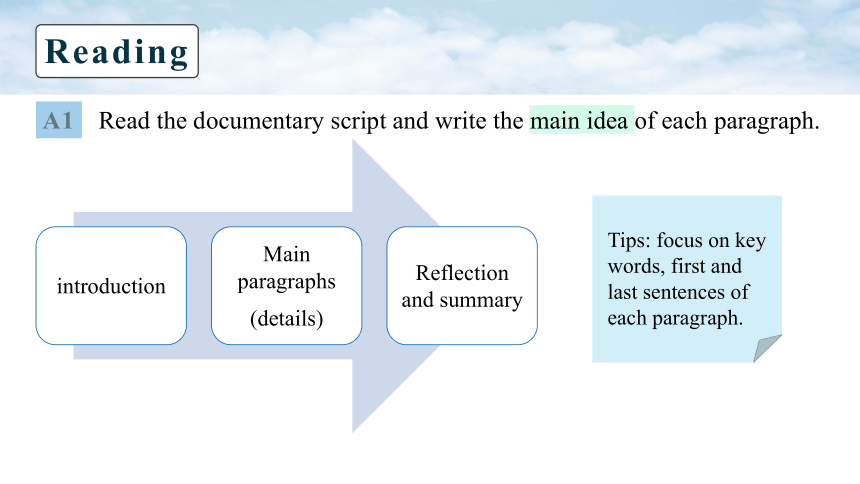




文档简介
(共37张PPT)
Unit 1Nature in the balance
Reading
Lead in
The world we live in is full of natural wonders. We can see uncountable species in our daily life…
sky
water
soil
ground
What animals/plants do you know about What is special about them
Lead in
Example:
tiger
catamount animal
yellow and black streaks, long tail
thick forest
small animals
Living space, food, hunting…
Appearance
Type
Habitat
Diet
Threat
Warm up for reading
Have you ever watched a documentary before
Warm-up for reading
Have you ever watched a documentary before
(of a film, television or radio programme, or photography) using pictures or interviews with people involved in real events to provide a factual record or report.
Warm-up
What do you think this script is about judging from the title and picture
The documentary script below describes the Amazon rain forest which is home to a wide rage of wildlife. Before you read the script, thing about the following question:
Warm-up for reading
What do you think this script is about judging from the title and picture
Wildlife and its habitat
Description, features
Benefit for nature and people..
Now, read the documentary, check your answers.
Reading
Read the documentary script and write the main idea of each paragraph.
A1
Tips: focus on key words, first and last sentences of each paragraph.
Reading
Amazon rainforst
Basic information about the rainforest
Plant biodiversity; levels of the rainforest
Introduction to the Amazon rainforest
The rainforest’s value to the human race; threats to the rainforest.
Animal biodiversity; food chain
1
2
3
4
5
Reading
Read the documentary script again carefully and fill in the blanks with the figure.
A2
Basic information about Amazon rainforest
Threat and benefit
Biodiversity
Reading
Sample answer:
8
6 million
6,400
40,000
1,300
400
20%
17%
Why does the documentary show these figures
Reading
Of the 390,000 plant species known to us, more than 40,000 can be found in the Amazon. This tall and ancient brazil nut tree produces nuts that we can eat; these water lilies are big enough to lie down on. The forest's different levels support an unbelievable variety of wildlife. At the bottom, there is a system of roots beneath the ground. Above that is the mass of leaf litter on the dark forest floor. The next level is made up of shorter plants with large leaves. Then there are the towering ancient hardwoods, and finally the tops of the tallest trees many metres above the ground. Each level of the forest forms its own little world, home to different kinds of living things.
Read Paragraph 3 and complete the mind map about different levels of the rainforest.
Reading
Reading
Read Paragraph 4 and complete the following chart about the food chain in the rainforest.
… These frogs, in turn, feed on insects which eat leaves and fruit. When jaguar dies, a tiny army of microorganisms helps break down its body and return the nutrients to the earth.
Reading
Insects
Frogs
Jaguars
Amazon rainforest
Reading
Watch the documentary video, fill in the chart below and summarise them.
Reading
Basic information
location and size
Name: getting its name from (1) ________________
richest (2) ____________
Amazon rainforest
Animals
more than 1,300 species of birds and over 400 species of (5) __________
elements of this forest’s (6) ___________
Plants
more than 40,000 (3) ______________
different (4) _____ of the forest
Significance
fix carbon and producing (7) ________
having species used for (8) __________________
Danger
the major danger: (9) _________________
disappearing due to human activities such as (10) ____________ and cattle farming
the Amazon river
biodiversity
plant species
levels
mammals
food chain
oxygen
food or medicine
us/human beings
agriculture
A3
Discussion
In pairs, discuss the following questions.
What makes the Amazon rainforest a natural treasure according to the script
Tips: think about its beauty, value and uniqueness, give some examples for supporting your ideas.
Discussion
What is your answer to the question at the end of the script Support your opinion with information from the script or other sources.
As the impact of human activities continues to frow and the list of species in danger of extinction becomes longer, we are left with a question: can we afford to damage the “lungs of the planet”
—— The Amazon rainforests: a natural treasure
e.g. Ecological security of the planet – balance of the ecosystem – provide food, oxygen…
Discussion
Are there any places in China with rich biodiversity like the Amazon rainforest What are they Introduce one to the class.
Source: 《中国自然地理图集》第三版
Discussion
Are there any places in China with rich biodiversity like the Amazon rainforest What are they Introduce one to the class.
Name of the place
Basic information
Plant biodiversity
Introduction
Value, threats to rainforest
Animal biodiversity or food chain
1
2
3
4
5
Discussion
Sentence pattern:
The _________ is a natural property. The_____ is of outstanding value for its diversity of landscapes and rich biodiversity. In ______, there are over _____ plant species, around ______ mammal species and more than ____ bird species. A large number of rare animals such as ________can be found.
Key words
agriculture
[U] the science or practice of farming 农业;农学;农艺
The number of people employed in agriculture has fallen in the last decade.
过去十年,农业从业人数已经下降。
impact
n. the powerful effect that sth has on sb/sth 巨大影响;强大作用
v. to have a direct effect影响;撞击;冲突;压紧(on,upon,with)
Her speech made a profound impact on everyone.
她的讲话对每个人都有深远的影响。
Key words
variety
[U] the quality of not being the same or not doing the same thing all the time
变化;多样化;多变性
[C] ~ (of sth) several different sorts of the same thing
(同一事物的)不同种类,多种式样
We all need variety in our diet.
我们都需要饮食多样化。
Key words
break down
v. 分解;发生故障;失败;毁掉;制服
They can sometimes break down and you have to spend time mending them.
它们有时会发生故障,你不得不花时间来进行修补。
Berry agrees and hopes her team's findings might one day help to break down plastics in landfills.
贝里对此表示同意,并希望她团队的研究结果有朝一日能帮助分解垃圾填埋场中的塑料。
Building your language
B1
The passage below is from a website about the Amazon plete the passage with the correct forms of the words and phrases in the box below.
Tips: think about its tenses, singular or plural, parts of speech, voice etc.
Building your language
The Amazon rainforest is home to a great (1) of plant life; however, its soil is surprisingly poor in nutrients. In fact, the soil in the region cannot support (2) for more than a few years. If a scientist is shown a report listing the nutrients of that soil, he or she will probably think that only desert plants can (3) in it! Then why is the soil so poor in nutrients For one thing, the rainy season has a(n) (4) on the soil. In the rainy season, the water level can rise to as high as 12 metres. When the water goes away, it takes away the nutrients in the soil. For another thing,
variety
agriculture
survive
impact
Noun
Noun
Verb
Noun
Building your language
(5) the Amazon’s hot climate, it is difficult for the soil to build up enough nutrients. Dead plants and animals
(6) more quickly. The nutrients are soon taken in by the roots of the plants deep (7) the ground. As a result, most of the forest’s nutrients are locked up in the plants themselves, (8) allowing them to grow at an unbelievable speed.
due to
are broken down
beneath
thus
Prep.
Verb
Prep.
Adv
Building your language
B2
The documentary script uses some words with negative prefixes. Note the following prefixes and think of more words formed with them. Then fill in the table below with as many as you can.
Prefixes
un- +verb/ adj.
dis- +verb/ noun
in-/im-/il-/ir- +b, m, p开头单词/ +l开头单词/ +r开头字母/+其他字母开头
non- +adj./noun
Building your language
Prefixes
un- unbelievable, unlimited, unhappy, unknown, unusual, unreal, unfortunate, unlucky, unkind
dis- disappear, disagree, disadvantage, dissatisfied, dishonest, disabled
in-/im-/il-/ir- incorrect, inactive, independent, invisible, impolite, imbalance, illegal, irreplaceable, irregular, irresponsible,
non- non-smoking, non-stop, non-existent, non-profit, non-fiction
Appreciation
B3
The documentary script compares the size of the Amazon rain forest with that of China, and the length of the Amazon River with that of the Yangtze River.
Why
Making comparisons with familiar places or objects will help readers gain a better understanding, and makes the information more precise and accurate.
Appreciation
B3
Find these comparisons in the script and think of similar comparisons for the figures below.
With an area of around 6 million square kilometres, the Amazon rainforest is more than half the size of China.
The Amazon River, from which the rainforest gets its name, is close to 6,400 kilometres in length—roughly 100 kilometres longer than the Yangtze River.”
Appreciation
Here are some expressions used to make comparisons:
the same size/length as …
as large/long as …
more than/larger than/longer than …
twice/three times as large/long as …
Practice
1. It was reported that in 2011, about 34 million people lived in the Amazon. (population of Canada: 37 million; population of Shanghai: 24 million)
about, more than
It was reported that in 2011, about 34 million people lived in the Amazon—that is about Canada’s total population.
…—that is 10 million more than the population of Shanghai.
Practice
2. From 2001 to 2012, about 177,000 square kilometres of the Amazon rainforest were lost. (size of New Zealand: 268,000 km2; size of Jiangsu: 107,200 km2)
more than half, twice
From 2001 to 2012, about 177,000 square kilometres of the Amazon rainforest were lost—that is more than half the size of New Zealand.
…—that is about twice the size of Jiangsu.
Homework
Write a summary of the script based on the chart discussed in class
Find more places needed our help and collect information.
Thank you!
Unit 1Nature in the balance
Reading
Lead in
The world we live in is full of natural wonders. We can see uncountable species in our daily life…
sky
water
soil
ground
What animals/plants do you know about What is special about them
Lead in
Example:
tiger
catamount animal
yellow and black streaks, long tail
thick forest
small animals
Living space, food, hunting…
Appearance
Type
Habitat
Diet
Threat
Warm up for reading
Have you ever watched a documentary before
Warm-up for reading
Have you ever watched a documentary before
(of a film, television or radio programme, or photography) using pictures or interviews with people involved in real events to provide a factual record or report.
Warm-up
What do you think this script is about judging from the title and picture
The documentary script below describes the Amazon rain forest which is home to a wide rage of wildlife. Before you read the script, thing about the following question:
Warm-up for reading
What do you think this script is about judging from the title and picture
Wildlife and its habitat
Description, features
Benefit for nature and people..
Now, read the documentary, check your answers.
Reading
Read the documentary script and write the main idea of each paragraph.
A1
Tips: focus on key words, first and last sentences of each paragraph.
Reading
Amazon rainforst
Basic information about the rainforest
Plant biodiversity; levels of the rainforest
Introduction to the Amazon rainforest
The rainforest’s value to the human race; threats to the rainforest.
Animal biodiversity; food chain
1
2
3
4
5
Reading
Read the documentary script again carefully and fill in the blanks with the figure.
A2
Basic information about Amazon rainforest
Threat and benefit
Biodiversity
Reading
Sample answer:
8
6 million
6,400
40,000
1,300
400
20%
17%
Why does the documentary show these figures
Reading
Of the 390,000 plant species known to us, more than 40,000 can be found in the Amazon. This tall and ancient brazil nut tree produces nuts that we can eat; these water lilies are big enough to lie down on. The forest's different levels support an unbelievable variety of wildlife. At the bottom, there is a system of roots beneath the ground. Above that is the mass of leaf litter on the dark forest floor. The next level is made up of shorter plants with large leaves. Then there are the towering ancient hardwoods, and finally the tops of the tallest trees many metres above the ground. Each level of the forest forms its own little world, home to different kinds of living things.
Read Paragraph 3 and complete the mind map about different levels of the rainforest.
Reading
Reading
Read Paragraph 4 and complete the following chart about the food chain in the rainforest.
… These frogs, in turn, feed on insects which eat leaves and fruit. When jaguar dies, a tiny army of microorganisms helps break down its body and return the nutrients to the earth.
Reading
Insects
Frogs
Jaguars
Amazon rainforest
Reading
Watch the documentary video, fill in the chart below and summarise them.
Reading
Basic information
location and size
Name: getting its name from (1) ________________
richest (2) ____________
Amazon rainforest
Animals
more than 1,300 species of birds and over 400 species of (5) __________
elements of this forest’s (6) ___________
Plants
more than 40,000 (3) ______________
different (4) _____ of the forest
Significance
fix carbon and producing (7) ________
having species used for (8) __________________
Danger
the major danger: (9) _________________
disappearing due to human activities such as (10) ____________ and cattle farming
the Amazon river
biodiversity
plant species
levels
mammals
food chain
oxygen
food or medicine
us/human beings
agriculture
A3
Discussion
In pairs, discuss the following questions.
What makes the Amazon rainforest a natural treasure according to the script
Tips: think about its beauty, value and uniqueness, give some examples for supporting your ideas.
Discussion
What is your answer to the question at the end of the script Support your opinion with information from the script or other sources.
As the impact of human activities continues to frow and the list of species in danger of extinction becomes longer, we are left with a question: can we afford to damage the “lungs of the planet”
—— The Amazon rainforests: a natural treasure
e.g. Ecological security of the planet – balance of the ecosystem – provide food, oxygen…
Discussion
Are there any places in China with rich biodiversity like the Amazon rainforest What are they Introduce one to the class.
Source: 《中国自然地理图集》第三版
Discussion
Are there any places in China with rich biodiversity like the Amazon rainforest What are they Introduce one to the class.
Name of the place
Basic information
Plant biodiversity
Introduction
Value, threats to rainforest
Animal biodiversity or food chain
1
2
3
4
5
Discussion
Sentence pattern:
The _________ is a natural property. The_____ is of outstanding value for its diversity of landscapes and rich biodiversity. In ______, there are over _____ plant species, around ______ mammal species and more than ____ bird species. A large number of rare animals such as ________can be found.
Key words
agriculture
[U] the science or practice of farming 农业;农学;农艺
The number of people employed in agriculture has fallen in the last decade.
过去十年,农业从业人数已经下降。
impact
n. the powerful effect that sth has on sb/sth 巨大影响;强大作用
v. to have a direct effect影响;撞击;冲突;压紧(on,upon,with)
Her speech made a profound impact on everyone.
她的讲话对每个人都有深远的影响。
Key words
variety
[U] the quality of not being the same or not doing the same thing all the time
变化;多样化;多变性
[C] ~ (of sth) several different sorts of the same thing
(同一事物的)不同种类,多种式样
We all need variety in our diet.
我们都需要饮食多样化。
Key words
break down
v. 分解;发生故障;失败;毁掉;制服
They can sometimes break down and you have to spend time mending them.
它们有时会发生故障,你不得不花时间来进行修补。
Berry agrees and hopes her team's findings might one day help to break down plastics in landfills.
贝里对此表示同意,并希望她团队的研究结果有朝一日能帮助分解垃圾填埋场中的塑料。
Building your language
B1
The passage below is from a website about the Amazon plete the passage with the correct forms of the words and phrases in the box below.
Tips: think about its tenses, singular or plural, parts of speech, voice etc.
Building your language
The Amazon rainforest is home to a great (1) of plant life; however, its soil is surprisingly poor in nutrients. In fact, the soil in the region cannot support (2) for more than a few years. If a scientist is shown a report listing the nutrients of that soil, he or she will probably think that only desert plants can (3) in it! Then why is the soil so poor in nutrients For one thing, the rainy season has a(n) (4) on the soil. In the rainy season, the water level can rise to as high as 12 metres. When the water goes away, it takes away the nutrients in the soil. For another thing,
variety
agriculture
survive
impact
Noun
Noun
Verb
Noun
Building your language
(5) the Amazon’s hot climate, it is difficult for the soil to build up enough nutrients. Dead plants and animals
(6) more quickly. The nutrients are soon taken in by the roots of the plants deep (7) the ground. As a result, most of the forest’s nutrients are locked up in the plants themselves, (8) allowing them to grow at an unbelievable speed.
due to
are broken down
beneath
thus
Prep.
Verb
Prep.
Adv
Building your language
B2
The documentary script uses some words with negative prefixes. Note the following prefixes and think of more words formed with them. Then fill in the table below with as many as you can.
Prefixes
un- +verb/ adj.
dis- +verb/ noun
in-/im-/il-/ir- +b, m, p开头单词/ +l开头单词/ +r开头字母/+其他字母开头
non- +adj./noun
Building your language
Prefixes
un- unbelievable, unlimited, unhappy, unknown, unusual, unreal, unfortunate, unlucky, unkind
dis- disappear, disagree, disadvantage, dissatisfied, dishonest, disabled
in-/im-/il-/ir- incorrect, inactive, independent, invisible, impolite, imbalance, illegal, irreplaceable, irregular, irresponsible,
non- non-smoking, non-stop, non-existent, non-profit, non-fiction
Appreciation
B3
The documentary script compares the size of the Amazon rain forest with that of China, and the length of the Amazon River with that of the Yangtze River.
Why
Making comparisons with familiar places or objects will help readers gain a better understanding, and makes the information more precise and accurate.
Appreciation
B3
Find these comparisons in the script and think of similar comparisons for the figures below.
With an area of around 6 million square kilometres, the Amazon rainforest is more than half the size of China.
The Amazon River, from which the rainforest gets its name, is close to 6,400 kilometres in length—roughly 100 kilometres longer than the Yangtze River.”
Appreciation
Here are some expressions used to make comparisons:
the same size/length as …
as large/long as …
more than/larger than/longer than …
twice/three times as large/long as …
Practice
1. It was reported that in 2011, about 34 million people lived in the Amazon. (population of Canada: 37 million; population of Shanghai: 24 million)
about, more than
It was reported that in 2011, about 34 million people lived in the Amazon—that is about Canada’s total population.
…—that is 10 million more than the population of Shanghai.
Practice
2. From 2001 to 2012, about 177,000 square kilometres of the Amazon rainforest were lost. (size of New Zealand: 268,000 km2; size of Jiangsu: 107,200 km2)
more than half, twice
From 2001 to 2012, about 177,000 square kilometres of the Amazon rainforest were lost—that is more than half the size of New Zealand.
…—that is about twice the size of Jiangsu.
Homework
Write a summary of the script based on the chart discussed in class
Find more places needed our help and collect information.
Thank you!
同课章节目录
- Unit 1 Nature in the balance
- Welcome to the unit
- Reading
- Grammar and usage
- Integrated skills
- Extended reading
- Project
- Unit 2 Natural disasters
- Welcome to the unit
- Reading
- Grammar and usage
- Integrated skills
- Extended reading
- Project
- Unit 3 The world online
- Welcome to the unit
- Reading
- Grammar and usage
- Integrated skills
- Extended reading
- Project
- Unit 4 Scientists who changed the world
- Welcome to the unit
- Reading
- Grammar and usage
- Integrated skills
- Extended reading
- Project
